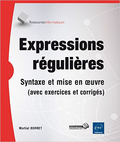GNU/Linux man pages
Livre :
Expressions régulières,
Syntaxe et mise en oeuvre :


GNU/Linux |
CentOS 4.8 |
i386 |
 |
slahrd(l) |
 |
SLAHRD - reduce the first NB columns of a real general n-by-(n-k+1) matrix A so that elements below the k-th subdiagonal are zero
|
SUBROUTINE SLAHRD( |
N, K, NB, A, LDA, TAU, T, LDT, Y, LDY ) | ||
|
INTEGER |
K, LDA, LDT, LDY, N, NB | ||
|
REAL |
A( LDA, * ), T( LDT, NB ), TAU( NB ), Y( LDY, NB ) |
SLAHRD reduces the first NB columns of a real general n-by-(n-k+1) matrix A so that elements below the k-th subdiagonal are zero. The reduction is performed by an orthogonal similarity transformation Q’ * A * Q. The routine returns the matrices V and T which determine Q as a block reflector I - V*T*V’, and also the matrix Y = A * V * T.
This is an auxiliary routine called by SGEHRD.
N (input) INTEGER
The order of the matrix A.
K (input) INTEGER
The offset for the reduction. Elements below the k-th subdiagonal in the first NB columns are reduced to zero.
NB (input) INTEGER
The number of columns to be reduced.
A (input/output) REAL array, dimension (LDA,N-K+1)
On entry, the n-by-(n-k+1) general matrix A. On exit, the elements on and above the k-th subdiagonal in the first NB columns are overwritten with the corresponding elements of the reduced matrix; the elements below the k-th subdiagonal, with the array TAU, represent the matrix Q as a product of elementary reflectors. The other columns of A are unchanged. See Further Details. LDA (input) INTEGER The leading dimension of the array A. LDA >= max(1,N).
TAU (output) REAL array, dimension (NB)
The scalar factors of the elementary reflectors. See Further Details.
T (output) REAL array, dimension (LDT,NB)
The upper triangular matrix T.
LDT (input) INTEGER
The leading dimension of the array T. LDT >= NB.
Y (output) REAL array, dimension (LDY,NB)
The n-by-nb matrix Y.
LDY (input) INTEGER
The leading dimension of the array Y. LDY >= N.
The matrix Q is represented as a product of nb elementary reflectors
Q = H(1) H(2) . . . H(nb).
Each H(i) has the form
H(i) = I - tau * v * v’
where tau is a
real scalar, and v is a real vector with
v(1:i+k-1) = 0, v(i+k) = 1; v(i+k+1:n) is stored on exit in
A(i+k+1:n,i), and tau in TAU(i).
The elements of the vectors v together form the (n-k+1)-by-nb matrix V which is needed, with T and Y, to apply the transformation to the unreduced part of the matrix, using an update of the form: A := (I - V*T*V’) * (A - Y*V’).
The contents of A on exit are illustrated by the following example with n = 7, k = 3 and nb = 2:
( a h a a a )
( a h a a a )
( a h a a a )
( h h a a a )
( v1 h a a a )
( v1 v2 a a a )
( v1 v2 a a a )
where a denotes an element of the original matrix A, h denotes a modified element of the upper Hessenberg matrix H, and vi denotes an element of the vector defining H(i).
 |
slahrd(l) |  |